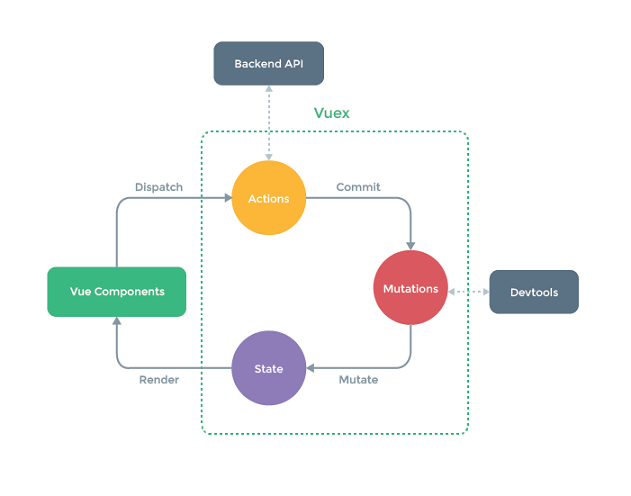Vuex

Vuex的核心是store(仓库),其是一个容器,包含着应用中大部分的状态(state)。 Vuex 和单纯的全局对象有以下两点不同:
Vuex 的状态存储是响应式的。当 Vue 组件从 store 中读取状态的时候,若 store 中的状态发生变化,那么相应的组件也会相应地得到高效更新。
不能直接改变 store 中的状态。改变 store 中的状态的唯一途径就是显式地提交(commit) mutations。
1.state
Vuex 使用 单一状态树 —— 用一个对象就包含了全部的应用层级状态。至此它便作为一个『唯一数据源(SSOT)』而存在。
这也意味着,每个应用将仅仅包含一个 store 实例(可以利用modules把store细分)。
vue组件内调用:
this.$store.state.count
getter
有时候我们需要从 store 中的 state 中派生出一些状态,例如对列表进行过滤并计数:
const store = new Vuex.Store({
state: {
todos: [
{ id: 1, text: '...', done: true },
{ id: 2, text: '...', done: false }
]
},
getters: {
doneTodos: state => {
return state.todos.filter(todo => todo.done)
}
}
})
组件内使用:
computed: {
doneTodosCount () {
return this.$store.getters.doneTodosCount
}
}
2.moutations
mutations 非常类似于事件:每个 mutation 都有一个字符串的 事件类型 (type) 和 一个 回调函数 (handler)。 mutation 必须是同步函数
mutations: {
//payload就是额外的参数
increment (state, payload) {
state.count += payload.amount;
}
}
组件内触发事件:
this.$store.commit('increment',{amount: 10}); 或者
this.$store.commit({
type: 'increment',
amount: 10
})
3.actions
与mutations不同之处:
- Action 提交的是 mutation,而不是直接变更状态。
- Action 可以包含任意异步操作。
actions: {
incrementAsync ({ commit }) {
setTimeout(() => {
commit('increment')
}, 1000)
}
}
组件内触发事件:
store.dispatch('incrementAsync', { amount: 10}); // 以载荷形式分发
或者
store.dispatch({ // 以对象形式分发
type: 'incrementAsync',
amount: 10
})
4.modules
使用单一状态树,导致应用的所有状态集中到一个很大的对象。但是,当应用变得很大时,store 对象会变得臃肿不堪。
为了解决以上问题,Vuex 允许我们将 store 分割到模块(module)。每个模块拥有自己的 state、mutation、action、getters、甚至是嵌套子模块——从上至下进行类似的分割:
const moduleA = {
state: { ... },
mutations: { ... },
actions: { ... },
getters: { ... }
}
const moduleB = {
state: { ... },
mutations: { ... },
actions: { ... }
}
const store = new Vuex.Store({
modules: {
a: moduleA,
b: moduleB
}
})
store.state.a // -> moduleA 的状态
store.state.b // -> moduleB 的状态
对于模块内部的 action,context.state 是局部状态,根节点的状态是 context.rootState:
const moduleA = {
// ...
actions: {
incrementIfOddOnRootSum ({ state, commit, rootState }) {
if ((state.count + rootState.count) % 2 === 1) {
commit('increment')
}
}
}
}